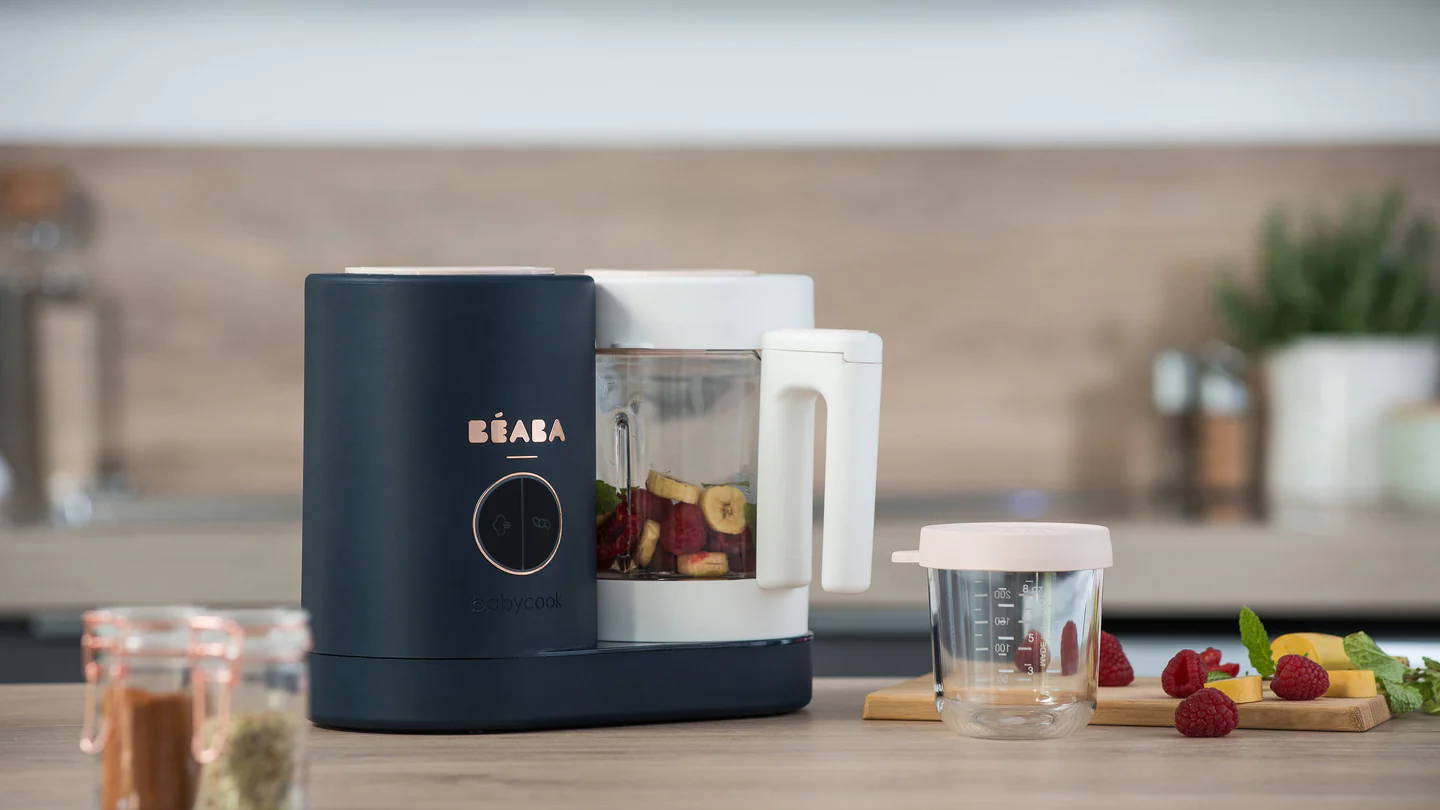When you start to wean your little one, you’re opening up an exciting new world of flavours, textures and tastes for them. With so many new foods to feel and play with, we’ve teamed up with Beaba and Registered Dietitian, Mummy Nutrition, to put together our top tips for weaning, as well as our must-have weaning essentials. From baby blenders to cutlery, bibs and splash mats, they’re all designed to make your mealtimes easier. So, you can concentrate on being there to make sure weaning is fun, safe and tasty for your baby.
How do you know if your baby is ready to wean?
First things first, you’ll need to make sure that your baby is ready to start weaning. You can usually start weaning when your baby is around six months old, but there are a few simple ways to make sure they’re ready.
Sitting up
To keep them safe whilst they eat, your little one should be able to sit up without your help when they’re in a highchair, or be able to hold themselves upright for a few seconds when they’re sat on the floor.
Hand-eye co-ordination
Your baby should also have some hand-eye co-ordination. Try giving them a spoon to hold – can they can focus their eyes on the spoon whilst bringing it to their mouth? If so, they should be ready for you to try weaning.
Tongue-thrust reflex
Your little one will also need to have lost their tongue-thrust reflex, which means they’ll be ready to swallow their food rather than spitting it out. This is really easy to check – gently press a clean finger or a spoon on your baby’s bottom lip. If they still stick out their tongue, they’re not quite ready.
Baby-led weaning vs spoon feeding
Baby-led weaning is when you give your little one a variety of finger food that they feed to themselves, rather than you spoon-feeding purees to them. Research suggests that baby-led weaning could help your baby develop good dexterity and hand-eye co-ordination, as well as nurturing some healthy eating habits – like chewing properly and stopping eating when they feel full. It also lets your little one lead the way when it comes to exploring new textures and tastes, helping them – and you – to learn what they do and don’t like.
It’s understandable that some mamas and papas might be concerned that baby-led weaning has a higher choking risk, but there’s no evidence to support this. There have also been concerns that parents whether baby-led gives your baby enough varied nutrients, as your little one has more control over the food they eat compared to being spoon fed. But at the end of the day, weaning is all about what you and your baby are comfortable with, and there’s no harm in doing a mixture of both baby-led weaning and spoon feeding.
What to expect during weaning
Weaning is all about trial and error, and it might feel at first that there’s more error than anything else! It’s important to keep in mind that weaning is a big learning curve for you and your little one, and baby’s reaction to this new way of eating is probably completely normal.
Food rejection
It’s inevitable that your baby will reject certain foods, especially bitter vegetables or unusual textures. But keep trying, mama – it’ll take a few goes for your baby to get used to those strong-tasting sprouts or crunchy toast crusts.
Mess
Let’s be realistic – weaning can get messy. Whilst your baby is getting used to different foods, they’ll want to mash it, smash it, smear it and probably spit it out, too. This is all part of the learning process, so try not to get too frustrated when you’re reaching for the mop again...
Unfinished meals
It’s normal for your little one to play with their food more than they swallow it in the early stages of weaning. But don’t worry if you think your little one isn’t getting enough food to keep them satisfied – it’s recommended that you keep up your usual breastfeeding or formula routine when you start to wean, so they won’t go hungry.
The weaning essentials checklist
Highchair
Investing in a good highchair will see you through many happy mealtimes with your little one. This Beaba Up & Down Highchair has a really simple push button system that lets you adjust the chair’s height, meaning your baby can eat with the rest of the family. Our top tip? Getting your little one used to sitting in a highchair from around 5 months old will make the weaning process so much easier.
Bibs
One thing’s for sure when you’re weaning – there’ll be times when more food goes on your baby’s outfit than in their mouth. To keep their clothes pristine and their faces clean, our range of bibs will save the day. If your child is particularly messy, wipeable bibs with sleeves are perfect for keeping their favourite sweater yoghurt-free.
Splash Mat
Whilst your little one will have plenty of fun splashing their snacks around, it’s likely that you won’t so having much fun cleaning up after them. That’s where a splash mat comes in. They go underneath your baby’s highchair to catch any mess, and they’re wipeable, so cleaning up after that lasagne explosion is a breeze.
Bowls and cutlery
Whilst it’s good for your little one to explore food that they can eat with their hands, getting them used to holding a spoon or a fork works wonders for their development. Once your baby can grip and move the spoon towards their mouths, they’ll be able to feed themselves. This Silicone Compartment Plate and Spoon set from Béaba is perfect for getting them started with using cutlery to scoop up food off a plate. The silicone spoon is soft on baby’s mouth, and the plate has a suction pad to help prevent those little accidents.
Baby Food Steamer Blender
When it comes to prepping baby’s first food, we love Beaba's range of baby food steamer blenders – they’re great all-in-one appliances that’ll make weaning so much easier. The Béaba Babycook steams, blends, defrost and reheats baby food within minutes.And to make it even easier, we’ve bundled together the Babycook Neo with some of their must-have accessories, including the Béaba Babycook Pasta/Rice Cooker, a Béaba Cookbook for meal inspiration and some Béaba Glass Storage Jars – perfect for batch cooking.
What foods should you give your baby?
6 Months
At this early stage in weaning, your little one is still developing their tastebuds. Although it might seem more natural to introduce sweet purées first, make sure you don’t offer your baby too much fruit, as it’s important that they get used to vegetable flavours from an early age. Try introducing pureed vegetables mixed with baby’s normal milk or as finger foods, or a combination of both. Once you’ve got them used to eating their greens, you can introduce softer pieces of slow cooked protein like beef, turkey or fish, as well as iron-rich eggs and lentils. Porridge and mashed potato will offer a little variety, whilst crust-less toast sticks are perfect for introducing a bit of texture. At this stage, it’s advised that you avoid honey and full fat, pasteurised cow’s milk, which could make your little one poorly.
Top weaning tip: Offer your baby food once a day when you first start weaning, and introduce your little one to new foods one at a time and in small amounts. This will help you spot any food allergies they might have.
Top weaning tip: From 7 months, start encouraging solid food three times a day to mimic your own meal times. You can start to experiment with baby rice at this stage, which is handy for thickening veggie and fruit purees.
From 10-12 months
pulses, so it’s important that you don’t add any extra salt or sugar to your baby’s meals. If you’re cooking a dish for the whole family, taking your baby’s portion out of the pan before you season it means you don’t have to miss out on the flavour.
Top weaning tip: To avoid choking when trying new foods, try and chop up small nibbles like grapes, popcorn or nuts, and softening or grating hard foods such as raw apples or carrots.
From 12 months
Your little one should now be enjoying three meals a day, with a couple of small snacks in between meals. You can also introduce them to full fat and pasteurised cow’s milk as a drink, as well as a drizzle of honey on their porridge or toast.
Top weaning tip: Little treats might be tempting, but sugary snacks like biscuits won’t give your little one any beneficial nutrients; whilst salty foods such as bacon, ham, bread and cheese should still be limited to protect your baby’s kidneys.
All the time
It’s good to get into the habit of giving your little one a small amount of water with their meals. Putting around 50ml in a free-flowing plastic cup will teach them how to sip without the cup being too heavy for them to hold. If your baby is under 6 months, it’s important to boil the water first, then let it cool. And when it comes to supplemental vitamins, the NHS recommends that you should be giving breastfed babies daily drops containing vitamins A, C and D. Formula fed babies will only need a supplement if they’re getting less than 500ml of formula a day, but you will need to increase the drops as you reduce the formula.
Related Products
Beaba Babycook Book - My First Meal
Beaba Babycook 4 in 1 Food Maker - Neo/Grey White
Beaba Training Baby Spoons & Forks
Weaning your little one can have its ups and downs, so it’s important that you try to keep it stress-free and enjoy the process. If you’re calm and relaxed, chances are your baby will be too, and it’ll be more likely that they’ll give all those exciting new flavours a go. Remember that not all babies are the same and your little one’s tastes will grow and change, so what makes their tastebuds tingle one day might not work the next – the joy is in trying new things and watching your baby learn to love their new favourite foods.













